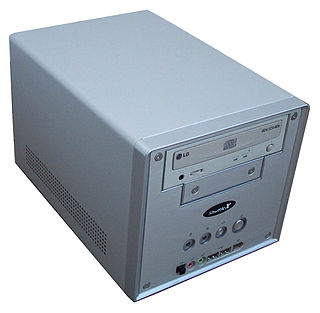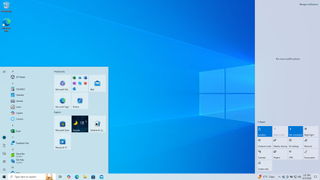
In computing, BIOS is firmware used to provide runtime services for operating systems and programs and to perform hardware initialization during the booting process. The BIOS firmware comes pre-installed on an IBM PC or IBM PC compatible's system board and exists in some UEFI-based systems to maintain compatibility with operating systems that do not support UEFI native operation. The name originates from the Basic Input/Output System used in the CP/M operating system in 1975. The BIOS originally proprietary to the IBM PC has been reverse engineered by some companies looking to create compatible systems. The interface of that original system serves as a de facto standard.
Product activation is a license validation procedure required by some proprietary software programs. Product activation prevents unlimited free use of copied or replicated software. Unactivated software refuses to fully function until it determines whether it is authorized to fully function. Activation allows the software to stop blocking its use. An activation can last "forever", or it can have a time limit, requiring a renewal or re-activation for continued use.
Retail software is computer software, typically installed on PC-type computers post 2005, delivered via the Internet. Traditionally this software was delivered via physical data storage media sold to end consumer but very few companies still provide their software using physical media. The software is typically sold under restricted licenses or in the case of cloud-based software sold as a Software-as-a-Service (SaaS) model.

American Megatrends International, LLC, doing business as AMI, is an international hardware and software company, specializing in PC hardware and firmware. The company was founded in 1985 by Pat Sarma and Subramonian Shankar. It is headquartered in Building 800 at 3095 Satellite Boulevard in unincorporated Gwinnett County, Georgia, United States, near the city of Duluth, and in the Atlanta metropolitan area.

Windows Preinstallation Environment is a lightweight version of Windows used for the deployment of PCs, workstations, and servers, or troubleshooting an operating system while it is offline. It is intended to replace MS-DOS boot disks and can be booted via USB flash drive, PXE, iPXE, CD, DVD, or hard disk. Traditionally used by large corporations and OEMs, it is now widely available free of charge via Windows Assessment and Deployment Kit (WADK).

A barebone computer is a partially assembled platform or an unassembled kit of computer parts allowing more customization and lower costs than a retail computer system. They are available for desktop computer, notebook and server purposes, and in nearly any form factor. Manufacturers are also able to produce systems of a specialized or non-standard form factor, since the system is sold as a pre-built unit, with the motherboard and power supply already installed.
Criticism of Windows XP deals with issues with security, performance and the presence of product activation errors that are specific to the Microsoft operating system Windows XP.

Windows Anytime Upgrade was a service by Microsoft introduced in Windows Vista that facilitated upgrades across successive editions of Windows Vista. Prices for upgrades purchased through Windows Anytime Upgrade were lower than prices for upgrades purchased at retail. Windows Anytime Upgrade is included in Windows 7 to allow users to upgrade to Windows 7 editions. In Windows 8 and Windows 8.1 it was rebranded as Add Features to Windows and was used to purchase an upgrade license for the Pro edition or to add Windows Media Center to an existing Pro installation. Support for this feature was discontinued on October 31, 2015.

The terms Recovery disc, Rescue Disk/Disc and Emergency Disk all refer to a capability to boot from an external device, possibly a thumb drive, that includes a self-running operating system: the ability to be a boot disk/Disc that runs independent of an internal hard drive that may be failing, or for some other reason is not the operating system to be run.
System Locked Pre-installation, often abbreviated as SLP, also referred to as OEM Activation, is a procedure used by major OEM computer-manufacturers in order to pre-activate Microsoft Windows before mass distribution.
Windows Vista—a major release of the Microsoft Windows operating system—was available in six different product editions: Starter, Home Basic, Home Premium, Business, Enterprise, and Ultimate. On September 5, 2006, Microsoft announced the USD pricing for editions available through retail channels; the operating system was later made available to retail on January 30, 2007. Microsoft also made Windows Vista available for purchase and download from Windows Marketplace; it is the first version of Windows to be distributed through a digital distribution platform. Editions sold at retail were available in both Full and Upgrade versions and later included Service Pack 1 (SP1).
Windows XP, which is the next version of Windows NT after Windows 2000 and the successor to the consumer-oriented Windows Me, has been released in several editions since its original release in 2001.
The bundling of Microsoft Windows is the installation of Microsoft Windows in computers before their purchase. Microsoft encourages original equipment manufacturers (OEMs) of personal computers to include Windows licenses with their products, and agreements between Microsoft and OEMs have undergone antitrust scrutiny. Users opposed to the bundling of Microsoft Windows, including Linux users, have sought refunds for Windows licenses, arguing that the Windows end-user license agreement entitles them to return unused Windows licenses for a cash refund. Although some customers have successfully obtained payments, others have been less successful.
Windows 7, a major release of the Microsoft Windows operating system, has been released in several editions since its original release in 2009. Only Home Premium, Professional, and Ultimate were widely available at retailers. The other editions focus on other markets, such as the software development world or enterprise use. All editions support 32-bit IA-32 CPUs and all editions except Starter support 64-bit x64 CPUs. 64-bit installation media are not included in Home-Basic edition packages, but can be obtained separately from Windows.

MS-DOS is an operating system for x86-based personal computers mostly developed by Microsoft. Collectively, MS-DOS, its rebranding as IBM PC DOS, and a few operating systems attempting to be compatible with MS-DOS, are sometimes referred to as "DOS". MS-DOS was the main operating system for IBM PC compatibles during the 1980s, from which point it was gradually superseded by operating systems offering a graphical user interface (GUI), in various generations of the graphical Microsoft Windows operating system.
Pre-installed software is software already installed and licensed on a computer or smartphone bought from an original equipment manufacturer (OEM). The operating system is usually factory-installed, but because it is a general requirement, this term is used for additional software apart from the bare necessary amount, usually from other sources.

Windows 8 is a major release of the Windows NT operating system developed by Microsoft. It was released to manufacturing on August 1, 2012, and was made available for download via MSDN and TechNet on August 15, 2012. Nearly three months after its initial release, Windows 8 finally made its first retail appearance on October 26, 2012.

Microsoft Product Activation is a DRM technology used by Microsoft Corporation in several of its computer software programs, most notably its Windows operating system and its Office productivity suite. The procedure enforces compliance with the program's end-user license agreement by transmitting information about both the product key used to install the program and the user's computer hardware to Microsoft, inhibiting or completely preventing the use of the program until the validity of its license is confirmed.

Windows 8.1 is a release of the Windows NT operating system developed by Microsoft. It was released to manufacturing on August 27, 2013, and broadly released for retail sale on October 17, 2013, about a year after the retail release of its predecessor, and succeeded by Windows 10 on July 29, 2015. Windows 8.1 was made available for download via MSDN and Technet and available as a free upgrade for retail copies of Windows 8 and Windows RT users via the Windows Store. A server version, Windows Server 2012 R2, was released on October 18, 2013.

Windows 10 is a major release of Microsoft's Windows NT operating system. It is the direct successor to Windows 8.1, which was released nearly two years earlier. It was released to manufacturing on July 15, 2015, and later to retail on July 29, 2015. Windows 10 was made available for download via MSDN and TechNet, as a free upgrade for retail copies of Windows 8 and Windows 8.1 users via the Windows Store, and to Windows 7 users via Windows Update. Windows 10 receives new builds on an ongoing basis, which are available at no additional cost to users, in addition to additional test builds of Windows 10, which are available to Windows Insiders. Devices in enterprise environments can receive these updates at a slower pace, or use long-term support milestones that only receive critical updates, such as security patches, over their ten-year lifespan of extended support. In June 2021, Microsoft announced that support for Windows 10 editions which are not in the Long-Term Servicing Channel (LTSC) will end on October 14, 2025.











